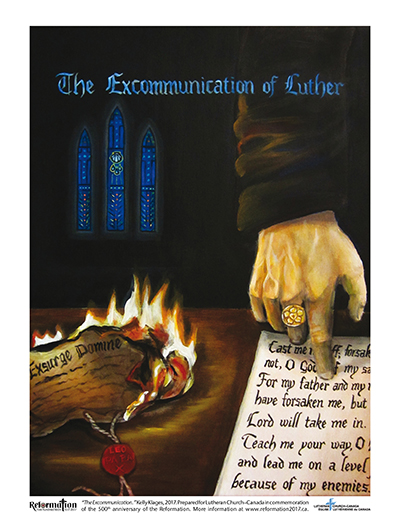Reformation 2017 Artwork: The Excommunication of Luther
Editor’s Note: Kelly Klages has agreed to prepare six pieces of original art for Lutheran Church–Canada (LCC) commemorating the 500th anniversary of the Reformation in 2017. Each piece of art will be featured on the covers of this year’s issues of The Canadian Lutheran magazine.
In addition, each piece of art is being made available to LCC congregations as a free, downloadable poster. You can print out the posters, along with accompanying artist’s statement, as they become available at www.reformation2017.ca/resources/posters/.
by Kelly Klages
 The theme for this second piece of artwork commemorating the Reformation is the excommunication of Luther and the burning of the papal bull. The 1520 decree of the pope Exsurge Domine (“Arise, O Lord”) denounced Luther as a heretic, based on his propositions from the 95 Theses and other writings. His excommunication came the following year, after he refused to recant—indeed, he intensified his positions—and publicly burned the papal bull. This was a crucial moment in Reformation history. Previously, Luther had believed that the extent of the abuses of the indulgence sellers was a problem relatively unknown to the pope. Now he knew the extent of the corruption; now his real defiance began in earnest.
The theme for this second piece of artwork commemorating the Reformation is the excommunication of Luther and the burning of the papal bull. The 1520 decree of the pope Exsurge Domine (“Arise, O Lord”) denounced Luther as a heretic, based on his propositions from the 95 Theses and other writings. His excommunication came the following year, after he refused to recant—indeed, he intensified his positions—and publicly burned the papal bull. This was a crucial moment in Reformation history. Previously, Luther had believed that the extent of the abuses of the indulgence sellers was a problem relatively unknown to the pope. Now he knew the extent of the corruption; now his real defiance began in earnest.
As with the posting of the 95 Theses, there is a very common visual that is associated with this scene: it’s a rabble-rousing Luther, well outside the church, flouting the authorities with hostile gestures. In this case, the zeal and gesture were genuine, but I think it is helpful to consider the event in light of Luther as the conservative reformer he was, not as a radical and eager defector. In this painting, I was interested in portraying Luther as a confessor of the faith still operating firmly and purposefully within the church. The occasion of his burning of the bull and subsequent excommunication is viewed here in light of its theological significance and personal meaning for Luther himself, rather than as a visual documentation of a moment.
It is helpful to consider the burning of the papal bull in light of Luther as the conservative reformer he was, not as a radical and eager defector.
The papal document, garnished with Leo X’s official seal, burns on the table in the foreground. Luther himself is identified by his own rose seal, which he designed to reflect his teachings and which has subsequently become the best-known symbol of Lutheranism. His hand points to words from Psalm 27, which are words of comfort in the face of persecution—particularly the following: “For my father and my mother have forsaken me, but the Lord will take me in” (verse 10). “Father and mother” in this context bring to mind the pope and the corruption of the Roman institution. For Luther, these had forsaken him in that they had opposed the words of Christ. The words Exsurge Domine may have been taken from the Psalms, but they nonetheless become a mockery of the words and promises of God.
Luther has the assurance, however, of God being his refuge, and the baptismal window in the background is a reminder of the sign and seal which is stronger and more efficacious than the pope’s. In Baptism, the Father has received us and taken us in for the sake of Christ, despite all the assaults of the devil.
———————
Kelly Klages is an artist and member of Lutheran Church–Canada living in Morden, Manitoba.





